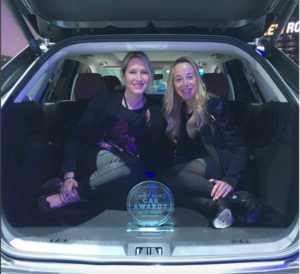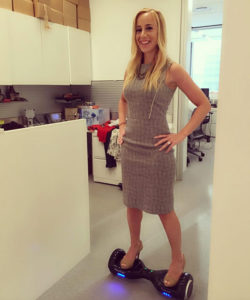What’s the fastest speed you have traveled without leaving the ground? Even in a zooming car on the highway, most people never go faster than 60 or 70 miles per hour (mph). Imagine climbing into a sports car and driving at a rate 100 mph faster than that. Mechanical Engineer Rachel Rothman, Chief Technologist and Engineering Director at Good Housekeeping, got that “roller-coaster stomach-drop sensation” at the Virginia International Raceway when an editor from Car and Driver accelerated the sports car they were testing (a McLaren) to more than 160 mph.
As you might imagine, Rothman tells Math4Science that she has a “fun, fun job.” She and her team try out all kinds of products — from race cars and televisions to computers; from shampoos and washing machines to sneakers and sports bras. Does each product work the way its advertisers promise?

Rothman doesn’t just check out how well things work when a consumer first unwraps them but also after that. What effects do time, cleaning, and other types of normal wear and tear have? In their labs, the people on Rothman’s staff find ways to test low-flow toilets, toys, washing machines, and all sorts of “the coolest gadgets.” As she works, Rothman uses numbers to measure each product. She also does qualitative testing, making careful observations about how they look, sound, feel, taste, and smell.
When deciding which toys deserve an award, her team looks at hundreds of them. They narrow those down to 100 toys by eliminating the ones that have dangerously sharp edges or break when they drop them. How well does each toy follow the U.S. government’s Consumer Protection Safety Commission’s regulations (particularly the ASTM F 963 requirements)? The team runs tests to answer that question and then they bring kids in to help them check out the “fun factor.” In 2014, for instance, Rothman and her colleagues brought 167 children into Good Housekeeping’s engineering lab to test the Air Hogs Rollercopter, Cool Circuits electronic puzzles, and other toys.

When testing cars, Rothman (with help from analysts at Car and Driver) rates their braking (ability to stop), acceleration (ability to speed up), leg room, trunk space, and other factors, each on a scale from one to five (five is the best score). They give each car an overall grade, based on ratings for dozens of different factors.
The one-to-five rating system applies to most products Rothman tries out. She and her colleagues do about 25 different quantitative and qualitative tests on televisions, looking at their picture quality and weight, for instance. When they analyze their ratings, they round them to the nearest tenth. Very few products earn a perfect five. “Depending upon the category, a 3.8 or higher might be good,” says Rothman.
Testing can be very dramatic, as it is when checking how flammable Halloween costumes are. Some “went up in flames in less than 3.5 seconds.”
Quantitative testing often involves cool tools, like the gloss meter Rothman uses to check paint’s opacity or luminance. This helps her figure out how much light gets through the paint. She evaluates each paint’s resistance to ultraviolet light, using a weathering tester, and to common stains, using a test protocol with specific quantities and sitting times for things like ketchup or ink. Does the stain come out right away? What happens if you don’t clean it up until six hours after it happened? And how easily is the paint scratched? Rothman uses a Taber machine to test wear and abrasions (scratches).

The Taber Instrument Corporation, which designed that machine, was founded in 1941 by Ralph Taber, an engineer. Rothman’s grandfather founded another company: M. Rothman & Company, Inc., an electronics distributor which her father and his brothers evenually took over. At home, they were always enthusiastically “shouting about computers” and other appliances “at the dinner table” and discussing how each product might be helpful to different people. As a child, Rachel loved taking things apart and imagining how they might work better. She hated umbrellas, wondering why the handle was in the middle, right where the person using it should stand to get the best protection from the rain. “If I were to make it,” she often wondered, “how would I do it?”
Rachel loved math and science classes. “I can do multivariable calculus at the drop of a dime,” but she wishes she had better spatial awareness when it comes to geography. As she got older and applied to college, engineering intrigued her. “Learning how things worked was always interesting to me.” This eventually led to working in the labs at Good Housekeeping. “This job ended up being the perfect marriage for me: every day is a new day and a fun day.” Sometimes that even means testing out a race car!


